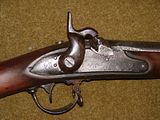Russ T Frizzen said:
Yes! A smoothbored military weapon was called a musket and it was the main battle weapon and assault weapon for a very long time. And they were grand guns indeed.
In America the term "rifled-musket" meant a true smoothbore musket that at a later point in its life had been given rifling. Since there now existed side by side in the same army two externally identical weapons, save in some cases for a rear sight on the rifled-musket, the two terms were necessary to differentiate them. And as time moved on and the Minie came into use, ammunition for the two weapons also differed--this time radically.
The rifle-musket retained many of the musket's features appearance-wise but was really an entirely new firearm, designed from the beginning to fire the Minie ball. It might well have been simply called a rifle except for one problem: there already existed a U.S. rifle. While there had been U.S. rifles going back to the Model of 1803, the Model of 1855 was in use as was the Model of 1841, both fine weapons. To avoid confusion, the Minie rifles were called rifle-muskets. It was all very simple and sensible to the military man a century and a half ago (and really still is) but many today want a rifle to be a rifle and a musket to be a musket and can't imagine or accept a melding of the two. There's some irony in the fact that terminology that was meant to clarify things back in the day is the source of so much confusion today!! :rotf:
Very well put! I just now found this thread (been off for a while) and was about to jump in until I saw that the different terms have been discussed. All of this can be confusing to a newcomer to military arms and I've seen where even oldtimers got confused.
To make things even more confusing, another word pops up when looking at reports and tables listing different arms during the CW era. That word is "altered". I've often run across it in reports of arms in store, &c. It simply describes a flintlock musket that has been converted to percussion, such as the majority of the M1816's, most which were simple alterations to a percussion lock, though as has been said earlier, several thousand were converted by Remington to use the Maynard primer. This lock and hammer design was later adopted for use on the new M1855 Rifle-Musket.
In some cases, the term "altered" included not just percussioning but rifling and sighting of the musket, but usually I've seen the term "altered and rifled" used in this case. However, there is at least one case where "altered" means something different. In
Small Arms - 1856 there is mentioned an "Altered Rifle Model 1841". Now, the M1841 was already percussion
and rifled. The term was used in this case to specify that the rifle's bore was enlarged and re-rifled from .54 to .58 caliber to accomodate the use of the 500 grain expanding ball (Minie). So readers of the history of these guns have to keep track of models or types of these guns and the periods of time in which they are described.
An interesting note about the term musket is the fact that several breechloading and repeating rifles were called muskets, such as some of the Winchester "High Wall" rifles, the Winchester M1895 Russian Model Musket and the Evans New Model Military Musket (made in the 1870's). And also even in more recent times, when a soldier was sentenced to die by firing squad, he was to be shot to death by musketry.
But now I'm just rambling.








